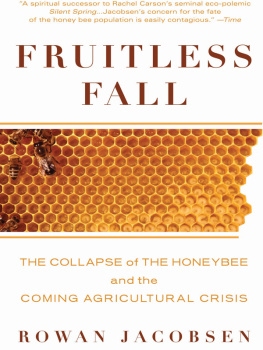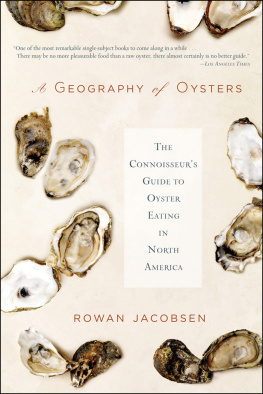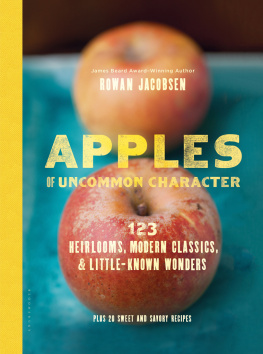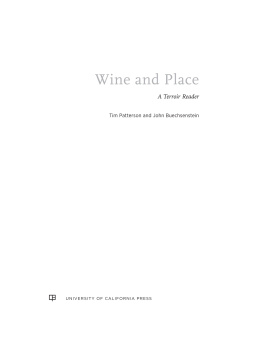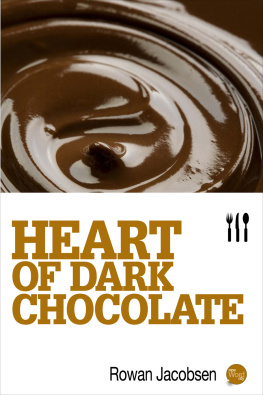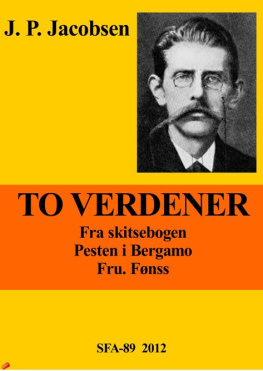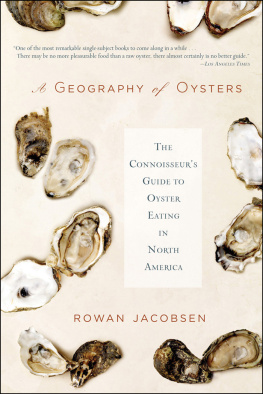Rowan Jacobsen - American terroir: savoring the flavors of our woods, waters, and fields
Here you can read online Rowan Jacobsen - American terroir: savoring the flavors of our woods, waters, and fields full text of the book (entire story) in english for free. Download pdf and epub, get meaning, cover and reviews about this ebook. year: 2010, publisher: Bloomsbury Publishing Plc, genre: Detective and thriller. Description of the work, (preface) as well as reviews are available. Best literature library LitArk.com created for fans of good reading and offers a wide selection of genres:
Romance novel
Science fiction
Adventure
Detective
Science
History
Home and family
Prose
Art
Politics
Computer
Non-fiction
Religion
Business
Children
Humor
Choose a favorite category and find really read worthwhile books. Enjoy immersion in the world of imagination, feel the emotions of the characters or learn something new for yourself, make an fascinating discovery.

- Book:American terroir: savoring the flavors of our woods, waters, and fields
- Author:
- Publisher:Bloomsbury Publishing Plc
- Genre:
- Year:2010
- Rating:5 / 5
- Favourites:Add to favourites
- Your mark:
- 100
- 1
- 2
- 3
- 4
- 5
American terroir: savoring the flavors of our woods, waters, and fields: summary, description and annotation
We offer to read an annotation, description, summary or preface (depends on what the author of the book "American terroir: savoring the flavors of our woods, waters, and fields" wrote himself). If you haven't found the necessary information about the book — write in the comments, we will try to find it.
American terroir: savoring the flavors of our woods, waters, and fields — read online for free the complete book (whole text) full work
Below is the text of the book, divided by pages. System saving the place of the last page read, allows you to conveniently read the book "American terroir: savoring the flavors of our woods, waters, and fields" online for free, without having to search again every time where you left off. Put a bookmark, and you can go to the page where you finished reading at any time.
Font size:
Interval:
Bookmark:
BY THE SAME AUTHOR
A Geography of Oysters
Fruitless Fall
The Living Shore
American Terroir
SAVORING THE FLAVORS OF
OUR WOODS, WATERS, AND FIELDS
Rowan Jacobsen

Copyright 2010 by Rowan Jacobsen
Map copyright 2010 by Mary Elder Jacobsen
All rights reserved. No part of this book may be used or reproduced in any manner whatsoever without written permission from the publisher except in the case of brief quotations embodied in critical articles or reviews. For information address Bloomsbury USA, 175 Fifth Avenue, New York, NY 10010.
Published by Bloomsbury USA, New York
LIBRARY OF CONGRESS CATALOGING- IN- PUBLICATION DATA
Jacobsen, Rowan.
American terroir : savoring the flavors of our woods, waters, and fields /
Rowan Jacobsen.1st U.S. ed.
p. cm.
ISBN 978-1-59691-648-7 (hardback)
1. Gastronomy. 2. Food cropsEcology. 3. Cookery. I. Title.
TX631.J335 2919
641.01'3dc22
2010006125
First published in the United States by Bloomsbury USA in 2010
This e-book edition published in 2010
E-book ISBN: 978-1-60819-459-9
www.bloomsburyusa.com
Contents
HIGH-MOUNTAIN MAPLE SYRUP, VERMONT
GEISHA COFFEE, PANAMA
NEW ENGLAND CIDER AND YAKIMA VALLEY APPLES
VARIETAL HONEYS OF NEW ENGLAND,
NORTH CAROLINA, FLORIDA, THE SOUTHWEST,
AND CALIFORNIA
MOULES FRITES ON PRINCE EDWARD ISLAND
FOREST GASTRONOMY, QUEBEC
TOTTEN INLET OYSTERS, PUGET SOUND
SLOW-RIPENED AVOCADOS, MICHOACN, MEXICO
YUKON RIVER SALMON
WINES WITHOUT MAKEUP, CALIFORNIA
WASHED-RIND CHEESE,
NORTHEAST KINGDOM, VERMONT
MESOAMERICAN CHOCOLATE, CHIAPAS, MEXICO
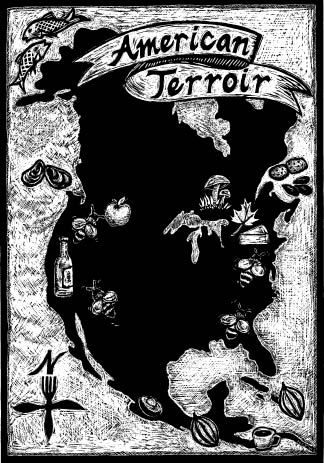
M Y NEIGHBOR PAUL has a field that grows great carrots. Thats a good thing, because Paul makes his living off that field, but its also a bit of a surprise. At first glance, you wouldnt expect it to grow great anything. It looks too high, too cold, and too poor. The soil is little more than ground-up schist. After a rain it looks like old pavement. You have to live there for years and learn to read the land, as Paul has, to start to recognize what works there.
Pauls place is called High Ledge Farm, with good reason. Its the kind of glacially scoured, hardscrabble New England hill farm that was settled only after all the choice river floodplain was taken. But it has wonderful character. The site has good exposure and drainage, so it dries out quickly and prevents the carrots from bursting open along a seam, which happens when carrots get too much water and try to grow too fast. Vegetables are just crunchy water, Paul likes to say. Sometimes they cant keep up.
The best thing about the carrots is the taste. Theyre amazingly sweet and flavorful, a little more carroty than most. They have a distinct bright flavor, and Paul thinks he knows why: This soil is really mineralized. When we tested it, we were off the charts for magnesium. Ive always felt that higher mineral content made things taste better.
Paul might be on to something. Magnesium ions are what give certain mineral waters their refreshingly tart taste, which is a pretty good way of describing these upland carrots. Then again, they are less uniform in appearance than river-valley carrots grown in deep, rich soil, which dont have to punch their way through and around rocks. Some people would argue that those lowland carrots are superior. For our purposes, what matters is that they are different. Same carrot seed, same year, two different farms, two different carrots.
Thats all you need to understand to begin to explore the idea of terroir , a French term, usually associated with wine, that can be translated as the taste of place. (Dont worry about sounding like Inspector Clouseau when you pronounce it; just say tare-wahr.) Like terrain and territory , it stems from the Latin word terra , earth. Its a new concept in the world of gastronomy, yet its not a new idea. If you grew up or spent time in the country, your family may have loved to get sweet corn from a particular farm stand. There may have been lots of farm stands in the area, but Farmer Browns corn always tasted better. There was something about Farmer Browns landthe soil, the water, the microclimate. He had the best spot, and he had the best corn.
Thats terroir. And its that simple. No one would argue that site conditions dont affect how things grow, that certain areas consistently produce better-quality food than others, yet somehow when the words to capture this take on a Gallic flare, the notion becomes a bit slippery and daunting. Thats too bad, because seeing food through the lens of terroir makes it more colorful, more meaningful, and even, I would argue, more delicious. My goal in this book is to demystify the concept, to wrest it from the sticky clutches of wine writers, and to present some shining examples of great foods that are what they are because of where they come from. Rather than any sort of encyclopedic coverage, Ive chosen a handful of foods to explore in depth. By understanding their essence, we can begin to understand our attraction to them, and maybe even learn a little about our place in the world.
The title of this book is anathema to a certain conservative European school of gastronomes, who believe that the Land of the Golden Arches is incapable of producing foods or drinks that embody a particular somewhereness, but I believe that North America, with its dazzle of terrains, climates, and cultures, holds terroir to rival Europes. We have a long way to go to tease out the best expressions of the terroir of many places, and an even longer way to go to cultivate a society that appreciates the attempt, but the past few years have seen such a blossoming of enthusiasm and creativity that I feel confident in asserting that American terroirs time has come.
The subjects in this book span the continent, from salmon in Alaska and apples in Washingtons Yakima Valley to chocolate in Mexico, coffee in Panama, cheese in Vermont, and wild mushrooms in Quebec. They ignore political boundaries but pay close attention to geological ones. Terroir almost invariably finds its roots in bedrock, in the workings of tectonic plates and glaciers, along with the realities of climate and geography. For this reason, my favorite work on terroir is not from the bottomless vat of wine writing. Rather, it is John McPhees magnum opus Annals of the Former World . In that work, McPhee traverses the continent, showing how the patterns of life of its inhabitants, human and otherwise, were set long ago by the deep movements of the earth. McPhee has a forerunner in Paul Vidal de la Blache, whose 1903 Tableau de la gographie de la France argues that the rapport between the soil and the people is imprinted with an ancient character that continues through today. As Amy Trubek points out in her wonderful book The Taste of Place , Vidal de la Blache shows how everything from the food and drink to the architectural styles of different regions of France has been influenced by climate and terrain. In doing so, he adds depth and definition to the character of each region.
But terroir encompasses more than just geology. The great wine writer Hugh Johnson says it best with a beautiful definition in his foreword to James Wilsons 1998 book Terroir : Terroir, of course, means much more than what goes on beneath the surface. Properly understood, it means the whole ecology of a vineyard: every aspect of its surroundings from bedrock to late frosts and autumn mists, not excluding the way a vineyard is tended, nor even the soul of the vigneron . Its a partnership between person, plant, and environment to bring something unique into the world. The soil and climate set the conditions; the plants, animals, and fungi respond to them; and then people determine how to bring out the goodness of these foods and drinks.
Next pageFont size:
Interval:
Bookmark:
Similar books «American terroir: savoring the flavors of our woods, waters, and fields»
Look at similar books to American terroir: savoring the flavors of our woods, waters, and fields. We have selected literature similar in name and meaning in the hope of providing readers with more options to find new, interesting, not yet read works.
Discussion, reviews of the book American terroir: savoring the flavors of our woods, waters, and fields and just readers' own opinions. Leave your comments, write what you think about the work, its meaning or the main characters. Specify what exactly you liked and what you didn't like, and why you think so.


